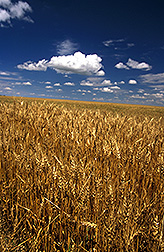This page has been archived and is being provided for reference purposes only. The page is no longer being updated, and therefore, links on the page may be invalid.
|
Read the magazine story to find out more. |
|
|
|
|
Genomic "Jigsaw Puzzle" for Wheat Scab Fungus Is Put Together
By Don ComisFebruary 2, 2005
The Agricultural Research Service has played a pioneering role in completing the mapping of the genome of the fungus that causes wheat scab.
The worst ever wheat and barley disease first struck worldwide in the 1990s. Farmers and scientists quickly realized that the usual methods of fighting crop disease--planting resistant crops and applying fungicides--wouldn't be enough. They needed ways to control the fungus genetically.
In 1999, geneticist Corby Kistler arrived at the ARS Cereal Disease Laboratory in St. Paul, Minn., to unravel the genome of the fungus known as Fusarium graminearum. He and University of Minnesota geneticist Liane Gale mapped its DNA, linking about 99 percent of its genome into a genetic map.
The project attracted a $1.9 million grant from the Microbial Genome Sequencing Program administered jointly by the U.S. Department of Agriculture and the National Science Foundation. Kistler shared the award with colleagues at Purdue University in West Lafayette, Ind.; Michigan State University in East Lansing; and the Broad Institute, a major genomics research center, in Cambridge, Mass.
The Broad Institute used sophisticated computer techniques to assemble a physical map from the hundreds of thousands of little bits of DNA sequences that make up all of F. graminearum's genes. Kistler and Gale linked together the last odd pieces. Last year, the institute integrated the Kistler/Gale genetic map into its physical map. The combined map is on the Broad Institute's website at:
www.broad.mit.edu/annotation/fungi/fusarium
The genetic map gives an overview of the order of the fungal chromosomes, while the physical map is more detailed. Information gained from the combined map has already accelerated the search for new ways to control wheat scab genetically. For example, the map is helping scientists find the genes that produce toxins that can render surviving wheat and barley unfit for consumption.
Read more about the research in the February 2005 issue of Agricultural Research magazine available online.
ARS is USDA's principal scientific research agency.


